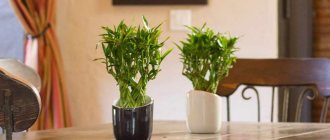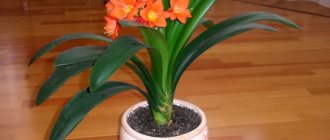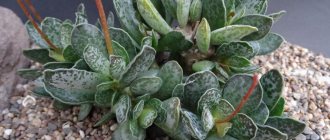Description and characteristics of the plant
Bamboo, which is used in the interior, belongs to the Dracaena family; only its appearance is similar to its wild counterpart.
Features of indoor bamboo:
- the stem is dense, fleshy with knotty isthmuses;
- green oblong leaves at the top;
- a healthy plant is bright green, the leaves are shiny, do not turn yellow or fall off, glossy and hard;
- does not bloom at home;
- grows both in soil and in water;
- feels good in conditions similar to natural ones.
The Chinese believe that bamboo brings happiness and good luck to the home.
Sharp turn
Bamboo is not born curly, it becomes so after “curling”
Often bamboo is purchased for only one purpose - to obtain a plant with a bizarre stem shape. Unfortunately, bamboo itself will not wrap itself in a perky spiral, but by organizing proper care and being patient, you have every chance of success:
| Photo | Description |
| Method 1. The plant is planted vertically. At the moment of bud formation, the bamboo is covered with a cardboard box, leaving a small hole for sunlight to penetrate. The sprouts will strive for sunlight and in order for them to “curl”, you will have to turn the bamboo in different directions relative to the “window” in the opaque covering structure. Thus, one spiral will be formed in a year. | |
| Method 2. The second option involves temporary cultivation in water. The stem is placed horizontally in a transparent container with water and wound onto a rod of suitable diameter. Subsequently, the bamboo is transplanted into the ground, the “curlers” are removed, and the curls are temporarily fixed with wire. |
Bamboo allows you to “twist ropes” and, for your sweet soul, will curl up not only into a spring, but also into an intricate lattice
Types and varieties of bamboo
- Ordinary bamboo. It blooms very rarely and is propagated by bush division. The stem is thick, rich green with bright yellow hues. In the wild it reaches 20 meters.
- Bloated bamboo. It grows up to 3 meters, is distinguished by thin branches and very lush foliage. Does not bloom at home.
- Multiple bamboo. It has the appearance of a shrub consisting of a large number of individual trunks, grows up to 40 m, the stems are thick and flexible, the leaves are hard, glossy, deep green.
- Indoor bamboo. A miniature plant, it produces hard and glossy leaves of a light green hue only at the top, the trunk is smooth and bare.
- Bamboo varnishes. A perennial subshrub with leafy shoots at the top and smooth trunks. The plant is rich green in color.
- Longispiculata bamboo. Grows up to 15 meters. The trunk is bare, gnarled, the leaves at the top are sharp and hard.
- Tulda. This bamboo is used to make paper. The plant is bright green in color, but then acquires a grayish tint, a trunk with thin branches and green foliage.
- Blumeana. It can grow as a shrub or with single stems. The trunk is thin, with a gray tint, covered with branches with thorns and dark green foliage.
Trimming
Strongly grown bamboo does not look very attractive, so it is advisable to prune it annually.
Advice! To make the cut look beautiful, it is carried out with special scissors immediately above the knot.
When pruning, long shoots are trimmed on all sides, and if necessary, external reeds are removed at ground level. By removing side shoots from the desired sides, you can simulate the appearance and shape of bamboo, giving it the shape of your own desire. The cuttings obtained during pruning can later be used for propagation. If after pruning a new shoot does not sprout, then the top is cut - after this a new shoot should break through.
A magnificent combination of orchids and indoor bamboo
Beautiful low bush of decorative bamboo
Advice! Be sure to trim off yellowed stems and leaves. After allowing the cut area to dry a little, it must be sprinkled with charcoal powder or lubricated with soft wax.
Reproduction
The optimal way to propagate indoor bamboo is vegetatively; for this, cuttings remaining after pruning are used, discarding the yellowed areas of the trunk. Propagation by cuttings can be carried out at any time of the year. And although you can sometimes find seeds of homemade bamboo in flower shops, its propagation in this way at home is almost impossible.
Dracaena sandera seeds
The cutting must be placed in water until roots appear. After this, it is rooted by choosing a spacious pot and filling it with ready-made soil mixture for dracaenas. The main requirements for propagation to go well and for the young plant to take root well and begin to grow are sufficient watering, plenty of light and fertilization once every 2 weeks.
Germinated cuttings
Requirements for growing bamboo at home
Bamboo is called a lucky plant. Growing it at home is a real pleasure; it is unpretentious and can live in a vase with water or in a pot with soil. The stems can be twisted into a spiral and made into compositions for room decoration. But in order for the plant to be healthy, there are some care features.
Lighting and location
Bamboo's natural habitat is the tropical forest, where the sun's rays are scattered. Therefore, it is better to place the plant on windowsills on the eastern side and it is advisable to have a light curtain on the window; the bright sun burns the leaves and they can turn yellow. But bamboo can also suffer from a lack of light, so if you want to place it in a dark corner or in the bathroom, provide additional lighting, for example, using fluorescent lamps.
Temperature
Indoor bamboo is heat-loving, tolerates heat up to +30 °C without any consequences, but the comfortable mode is from 18 to 25 degrees plus. The plant loves fresh, clean air, so ventilation will benefit it.
Air humidity
And here bamboo is not whimsical, but it is better to avoid dry air and not place the plant near heating devices. The leaves need to be wiped off dust more often and given a warm shower.
Water for bamboo
In many apartments and houses, bamboo is grown in water, because its straight or twisted shoots look very impressive in various glass vases. But then you will need to feed it with mineral fertilizers to preserve the green color of the leaves.
The water in the vase with it must be filtered, or preferably distilled, at room temperature. It must be updated every 2 weeks.
You can also use rain or melt water - pour filtered or plain tap water into a plastic bottle and place in the freezer until the water completely turns into ice. Then put the bottle to thaw at room temperature. The resulting water becomes soft and more suitable for growing bamboo in it. If the water has acquired an unpleasant odor or a suspicious color earlier than 2 weeks, then you should change it and subsequently change the water in the vase with bamboo more often. If its leaves turn yellow, then the water also needs to be changed.
Ways to grow indoor bamboo
Growing bamboo in a container with soil
Bamboo feels better in soil than in water. It develops a good root system and you can grow a beautiful plant, the size of which will depend on the development of the roots. The smaller the pot, the shorter the stems will be.
Instructions for growing in soil:
- choose a pot, preferably squat with a large diameter;
- It is better to purchase special soil for growing dracaenas, but you can also mix peat, humus and clay turf yourself;
- ensure good soil drainage;
- once a month the plant needs to be fed;
- the soil should be constantly slightly moist, but not too wet;
- Replantation is recommended every three years.
Growing bamboo in water
Bamboo feels good in water and produces abundant leaves, but this method requires discipline - the water must be changed at least once a week.
Instructions for growing in water:
- prepare the root system, remove damaged roots;
- select a high container, something like a flask;
- filtered water can be used, but settled water will not cause harm;
- Carefully place the plant in a container and cover the roots with decorative stones;
- the water should always be clean, do not let it stagnate and bloom;
- Once a month you need to fertilize the plant.
Growing bamboo in hydrogel
The process is identical to that of growing in water with decorative stones, but somewhat simpler. Instead of stones, the roots are covered with granules and filled with clean water, then all that is necessary is to add water as needed and feed once every six months. It is better to choose a hydrogel with small granules, they will not allow the root system to be exposed.
Advice! In a container with bamboo, you need to maintain a low water level, just so that the roots are covered; if the trunk is in the water, then roots will appear at this distance, which does not look aesthetically pleasing.
How to transplant
The growth of the root system of bamboo occurs quickly, so planting should be done annually. This is best done in the spring. For subsequent transplants, you need to take an even larger pot. The container should be moderately wide and deep, so that the distance from the edge of the pot to the stems is at least 5 cm.
When dividing the bush, make sure that the root system is sufficiently developed. Try not to damage the rhizome.
The soil mixture used for replanting includes:
- 1 part humus;
- 1 part peat;
- 2 parts clay turf soil.
Don't forget to put drainage on the bottom. A newly transplanted plant needs proper maintenance, combining good watering and fertilizing.
Plant rejuvenation
Bamboo grows quickly, and the leaves need to be trimmed to prevent the plant from acquiring a shapeless and neglected appearance. Old leaves can be cut off completely. The cut areas are treated with charcoal powder. The crop is pruned to remove wilted, dead, diseased leaves, as well as to rest the plant.
Rejuvenation of bamboo requires subsequent care, including abundant watering, good lighting, fairly humid air, and high temperature. Pruning can stimulate the crop and accelerate its growth.
Indoor bamboo: care at home
Watering
Indoor bamboo is very moisture-loving and requires regular watering. The difficulty is that oversaturation with moisture must be avoided.
- If the plant is in water, make sure that it completely covers the roots. The water needs to be completely changed every week.
- Bamboo in the ground must be watered once every three days and the soil should not be allowed to dry out; the plant needs to be sprayed at the same frequency. If you are away from home for a long time, provide automatic watering.
Feeding and fertilizers
The plant needs to be fed during the active growth phase. The frequency of feeding is once every 20 days. In winter - once every two months.
It is better to take fertilizers for bamboo specialized for dracaenas; it must contain nitrogen and phosphorus.
Advice! It is better not to fertilize dracaenas purchased in the store before 6 months. In stores and nurseries, all flowers receive a huge amount of fertilizer.
Transplantation, water change and substrates
Until the age of 4 years, the plant is replanted every year, like other flowers; replanting is recommended in the spring. Adult bamboo needs to be replanted no more than once every 3 years. After transplantation, the plant will acclimatize for about 2 months, then it will begin to develop as usual.
If bamboo grows in water, then “transplantation” is carried out as soon as signs of sediment appear. In this case, there is no need to change the vase; you need to carefully remove the plant, pour in clean filtered water and return the plant back.
When planted in water, the plant does not need a substrate, but to secure the thin roots, it is better to add pebbles or decorative stone to the water. The substrate needs to be washed with each transplant (the hydrogel is not washed, it is changed at intervals recommended by the manufacturer).
Bamboo blossom
Flowering for bamboo is an extremely rare process; it is believed that indoor bamboo does not bloom at all. But if you are lucky and your pet blooms, most likely it will die after that. The plant spends all its energy and nutrients on flowering. If you want to preserve the bamboo, then the flower arrow needs to be cut off and the cut area treated with charcoal.
Trimming
Bamboo is very tolerant of pruning and tolerates it well. Designers adore him for this - he can create various interior compositions.
Trimming rules:
- You need to prune when the plant is completely healthy and rooted;
- First, excess stems and dry leaves are cut off;
- to prevent the stem from growing upward, pruning is done above the branching point;
- lastly, remove excess shoots.
How to twist a bamboo trunk
The plant is quite elastic, which allows bamboo to be molded into various shapes. But the process is slow and requires patience.
Step-by-step instructions for twisting:
- Place a guide in the pot with the plant, around which the stem will curl. The sprout must be securely attached to the guide. You can remove the structure when the stem becomes rigid.
- Cover the bamboo with something opaque and leave a hole for sunlight to enter - that’s where the bamboo will tend to grow. For example, you can take a box, place a plant there and remove only one wall, the stem will begin to turn towards the sun.
- To twist the stems together, the sprouts are carefully twisted and secured with wire. After the stems have strengthened and become strong, remove the wire; the trunk will remain in this position.
How to twist the stems. Step-by-step instruction
The young plant has elastic stems that allow it to give an interesting shape to the trunk. But this process is slow and requires caution and patience. We'll tell you how to twist the leaves yourself to give the plant the desired shape:
- Fixation with an object. To do this, a guide is fixed in the pot, for example, a cylinder or a stick, around which the stems are wrapped. To fix the sprout, it is attached with wire. The structure is dismantled after the stem becomes woody. If you need to form a crown, then the leaves at the bottom are cut off and the greenery remains only at the top.
- Using a cylindrical transparent tube of an unusual shape, into which a bamboo stem is placed. As a result, its growth is forced to continue within the given parameters. The cylindrical pipe may also be opaque.
- Any plant reaches for sunlight. You can take advantage of this law of nature by placing bamboo in a box that shields it from light on three sides. We leave the fourth side open, and the stem will stretch there. As it grows, the remaining doors of the box open.
- If a young plant is bent, it can be straightened, but this requires even more work and time. Clamps and supports are used for this purpose. Interesting compositions are created from the stems and even “braids” are braided.
How to propagate happiness bamboo
Cuttings
Propagation by cuttings is carried out in the spring. Separate the young branches from the adult plant and transplant them into the ground. The soil mixture is standard for dracaenas. Roots will appear in about a month. Cuttings can be combined with annual replanting of bamboo.
Seeds
The most difficult and time-consuming method, and indoor varieties are almost impossible to grow from seeds.
How to germinate bamboo seeds:
- build a mini-greenhouse on the windowsill;
- soak the seeds in warm water;
- plant the seeds in peat tablets and sprinkle with soil mixture;
- ventilate the greenhouse 2-3 times a day;
- moisten the substrate regularly;
- sprouts will appear in approximately 10–20 days.
Plant the germinated seeds in open ground and wait for shoots to appear, which you can then replant in the standard way.
Dividing the roots
This method of reproduction is extremely rare. When an adult plant is transplanted, at this moment large shoots are separated and immediately planted in the soil in a separate container. Until the shoot takes root, it needs to be watered abundantly.
Answers on questions
Is it possible to keep bamboo in an apartment?
Indoor bamboo is specially bred for growing at home. According to Feng Shui philosophy, bamboo attracts good luck and happiness to the house, and grants longevity to the owner. That's why it is called lucky bamboo.
Why does bamboo turn yellow?
The evergreen plant may turn yellow. This may happen due to:
- lack of light;
- exposure to direct sunlight;
- lack of moisture;
- lack of nutrients;
- poor drainage system;
- drafts;
- watering with unfiltered water.
How fast does indoor bamboo grow and what to do if it grows very slowly
The growth rate is incredible; on average, bamboo reaches medium size in 5 years. If the dracaena suddenly stops growing, this indicates watering with hard water and lack of light.
Leaf blades become limp and curled
This is due to hypothermia.
Why do black spots appear on bamboo leaves?
Bamboo is affected by fungus; ventilation must be provided.
Is it possible to prune indoor bamboo?
It is possible and necessary to trim homemade bamboo; this is often done for decorative purposes.
How to root bamboo at home
For rooting, pinch off the top and place in a glass of water until roots appear. When the first shoots appear, the bamboo is planted in a pot with soil.
Types of diseases
If a coating similar to flour has formed on the leaves, this means that the plants have been affected by powdery mildew. Brown spots indicate the presence of gray rot, and the yellow color of the leaf blade indicates brown rot. A fairly common bacteriosis affects the stem and tips of the leaf blade. A brown canker appears on the trunk, and watery streaks appear at the ends of the leaves. To treat all fungal diseases, there are special preparations that can be purchased at any flower shop. Their appearance is most often caused by poor quality water and the cool temperature of the room where the flower is kept.











